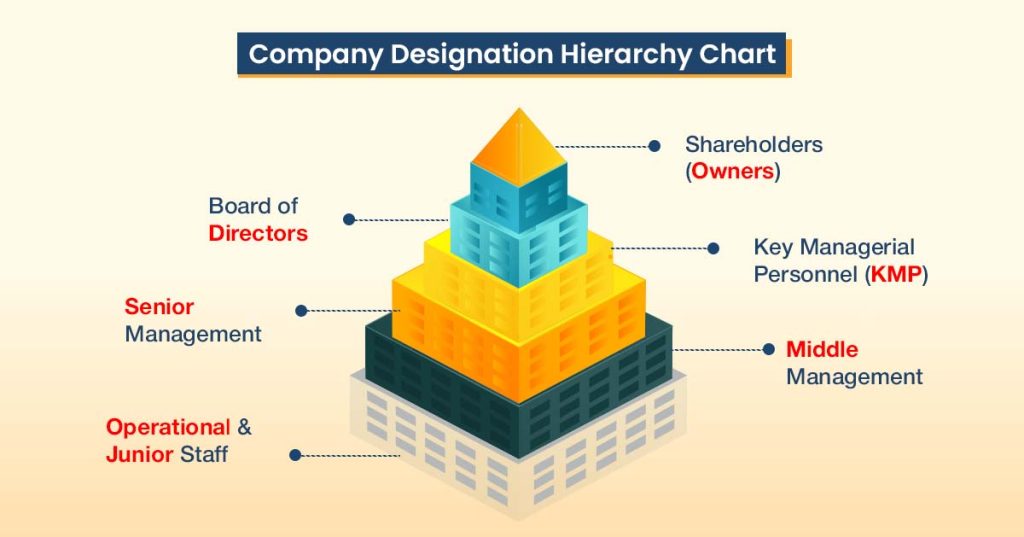
A company operates through a structured framework, where people perform specific roles that contribute to the organization’s success. This structure is defined by a designation hierarchy in a private company, which helps in managing responsibilities and aligning goals within the company. But why is this hierarchy so vital?
The designation hierarchy in a private company ensures that employees understand their responsibilities and can communicate efficiently. You see, when roles are clear, work moves faster, and confusion is reduced. This also allows for better decision-making and streamlined operations.
This article looks into the levels of private company designations, from top-level management to entry-level positions, and outlines their role in decision-making, communication, and enhancing organizational performance. A clear hierarchy helps lead teams, track performance, and set expectations precisely. It also supports smooth communication. When every employee knows their place in the structure, you avoid overlap and delays.
What Does Designation Hierarchy Mean in a Private Company?
A designation hierarchy in a private company refers to the systematic structure that outlines the chain of command, roles, and responsibilities within the organization. This organizational structure enables clear reporting lines and accountability, helping in the effective delegation of tasks and the smooth functioning of operations.
The company designation chart explains who leads, who manages teams, and who handles daily work. You use this structure to set reporting lines, define tasks, and ensure accountability. When roles are clear, employees know what they must deliver and who they must update.
The roles and responsibilities in a private company are clearly set out in the organizational structure, which helps maintain order and efficiency. While exact roles can vary across companies depending on size and industry, the general company hierarchy chart is as follows:
- Shareholders (Owners): Hold the company’s equity
- Board of Directors: Includes Managing Director (MD), Executive Directors, and Non-Executive Directors.
- Key Managerial Personnel (KMP): CEO / CFO / COO
- Senior Management: General Managers, Heads of Departments (HR, Finance, Operations, Marketing, IT, etc.)
- Middle Management: Managers, Assistant Managers, Team Leads
- Operational/Junior Staff: Executives, Associates, Coordinators
This structure ensures transparency, accountability, compliance, and smooth business operations in a Private Limited Company.
Importance of a Company Designation Chart
While applying for private limited company incorporation, the significance of a well-defined designation hierarchy cannot be overstated. Here are some of the key reasons why clarity in organizational structure is crucial:
- Clarity in Roles: Employees know their specific roles and reporting lines, reducing confusion and overlapping duties, which strengthens the company’s designation hierarchy.
- Effective Decision-Making: A clear designation hierarchy in a private company ensures that decisions are made by the right individuals at the right level, ensuring informed and timely choices.
- Improved Communication: Proper communication channels within the organizational structure facilitate smooth and effective information flow, essential for the company’s operations.
- Workplace Efficiency: With defined roles and responsibilities in a private company, tasks are allocated efficiently, and bottlenecks are avoided in the designation hierarchy, leading to more effective management.
The roles and responsibilities in a private company should be aligned with the company’s organizational structure, ensuring that every individual’s tasks are clearly defined.
Types of Management
Management is an essential function within any organization, involving planning, organizing, leading, and controlling resources to achieve organizational goals. The designation hierarchy in a private company ensures that these management functions are performed by the appropriate people at each level within the organizational structure.
Here are the most common types of management:

1. Top-Level Management
Leaders at the top of an organization’s hierarchy make long-term strategic choices about the company’s development and direction. The following executives are vital in determining the company’s future:
a. CEO (Chief Executive Officer)
The CEO holds the highest-ranking position in the company, overseeing the overall direction and making key decisions. They set long-term strategic goals, make high-level policy decisions, and are directly accountable to the board of directors. Hence, the appointment of a CEO is central in shaping the designation hierarchy in a private company.
b. Managing Director
The Managing Director is second in command after the CEO. Section 2(54) of the Companies Act, 2013 defines Managing Director. Their role often involves managing daily operations, implementing policies, and ensuring alignment with the company’s long-term goals.
c. Board of Directors
The Board of Directors is a group of elected professionals who represent the shareholders and provide oversight to the top management. They are responsible for making critical governance decisions and ensuring the company’s policies align with ethical and legal standards.
2. Middle-Level Management
Middle-level management acts as a bridge between the top leadership and the operational teams. Their role is crucial in translating the strategic goals set by top management into actionable plans at the departmental level. Middle managers play an important part in maintaining the company’s designation hierarchy and ensuring alignment with the organizational structure.
a. General Manager
The General Manager is responsible for overseeing specific regions or departments, such as marketing, sales, or operations. They handle budgeting, team performance, and ensure that their area meets the company’s objectives, supporting the overall designation hierarchy in a private company.
b. Department Heads
Department Heads lead specialized teams such as Human Resources, Finance, Marketing, or Operations. They play an essential role in setting departmental goals, monitoring team performance, and reporting progress to higher management.
3. Lower-Level Management
Lower-level management focuses on the implementation of operational tasks and day-to-day management. These roles help ensure that strategic goals are translated into tangible outputs, contributing to the company’s designation hierarchy and workflow within the organizational structure.
a. Team Leaders
Team Leaders manage smaller groups within departments, assign tasks, and ensure that work is completed on time. They work directly with employees to provide guidance and help solve any issues that arise.
b. Supervisors
Supervisors oversee specific teams or shifts, ensuring that employees adhere to safety standards and company policies. They play a pivotal role in monitoring performance, enforcing regulations, and escalating issues to higher management when necessary.
4. Entry-Level Positions
Entry-level employees are typically involved in executing routine tasks that are necessary for the company’s functioning. The designation hierarchy in a private company places them at the foundation, allowing for growth opportunities within the organizational structure.
a. Associates and Executives
Associates and Executives generally hold specialized roles in departments like marketing, finance, or operations. They may require certain expertise or experience, and their work contributes to the execution of the company’s objectives.
b. Trainees and Interns
Trainees and interns represent the entry point into the workforce. These positions are designed to offer individuals hands-on experience and exposure to the organization’s operations, often leading to full-time opportunities after successful completion.
Department-Wise Designation List in a Private Limited Company
A private limited company runs multiple departments, and each one follows its own reporting chain. When you understand designations by department, you can assign work clearly, set reporting lines, and avoid confusion within teams. This section helps you see how roles are structured across common departments, so you can map responsibilities without overlap. It also supports employees who want to understand growth paths inside their function.
Below is a clean and practical list of designations used in different departments across private companies in India.
1. Human Resources (HR)
- HR Head
- HR Manager
- HR Executive
- HR Assistant
- Recruiter
- HR Trainee
2. Finance and Accounts
- Chief Financial Officer
- Finance Manager
- Accountant
- Accounts Executive
- Junior Accountant
- Finance Trainee
3. Operations
- Operations Head
- Operations Manager
- Assistant Manager
- Operations Executive
- Shift Supervisor
- Operations Associate
4. Sales and Business Development
- Sales Head
- Regional Sales Manager
- Sales Manager
- Sales Executive
- Business Development Executive
- Sales Associate
5. Marketing
- Marketing Head
- Brand Manager
- Digital Marketing Manager
- Social Media Executive
- Content Executive
- Marketing Associate
6. IT and Technical
- Chief Technology Officer
- IT Manager
- Software Developer
- Network Engineer
- IT Support Executive
- Technical Associate
7. Customer Support
- Customer Support Manager
- Team Leader
- Support Executive
- Customer Care Associate
- Helpdesk Trainee
This functional designation list makes it easier to create accurate job structures, plan hiring, and define clear reporting relationships within each unit. It also supports SEO for readers searching for designations in a private limited company across different teams.
How Designations Impact Decision-Making and Workflow?
The designation hierarchy in a private company plays a critical role in determining how decisions are made and how the work process flows within the organization. With a well-structured organizational structure, decision-making becomes more streamlined:
- Top-level executives focus on strategic, long-term decisions.
- Middle managers implement the strategies and adapt them to departmental needs.
- Lower-level employees execute operational tasks that align with the organization’s goals.
This hierarchical approach ensures that decisions are made by individuals with the right expertise, leading to more efficient operations and better decision outcomes.
Tips for Creating a Balanced Organizational Hierarchy
Creating an effective designation hierarchy in a private company requires balancing structure with flexibility. Here are some key tips:
- Align Roles with Responsibilities: Ensure that each role in the hierarchy aligns with the responsibilities it entails. Employees should understand exactly what their roles demand and whom they report to.
- Maintain Flexibility: While structure is vital, companies must be flexible to adjust to dynamic market conditions and evolving needs within the designation hierarchy.
- Encourage Open Communication: Facilitating open lines of communication across all levels of management will ensure that the hierarchy is effective and responsive.
- Keep Communication Channels Open: Employees should know exactly who to approach for issues or guidance, which fosters better decision-making and problem-solving.
Ending Note
A clear designation hierarchy is essential for smooth communication, quick decision-making, and proper task delegation in a private company. In Indian businesses, where structures can be complex, a defined hierarchy outlines each employee’s role, improves efficiency, and ensures work is handled at the right level of expertise.
It also strengthens organisational culture by giving employees clarity and purpose, boosting motivation and productivity. With clear accountability and streamlined workflows, companies achieve better team alignment, stronger cohesion, and sustained growth.
Also Read: Promoters of a Company: Roles, Responsibilities, and Legal Insights
Frequently Asked Questions
The designation hierarchy establishes the chain of command, defines roles and responsibilities in a private company, and clarifies the communication channels within the organization.




